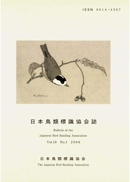All issues

Volume 19 (2006)
- Issue 2 Pages 37-
- Issue 1 Pages 1-
Volume 19, Issue 1
Displaying 1-4 of 4 articles from this issue
- |<
- <
- 1
- >
- >|
-
Tomomi KUROKI, Nobuhiko KATAOKA, Manabu KAJITA, Manabu MIHARA2006 Volume 19 Issue 1 Pages 1-7
Published: 2006
Released on J-STAGE: August 20, 2015
JOURNAL FREE ACCESSVarious external parasites, including louse flies, mallophagans, fleas and mites, are known to infest birds. Of these, feather mites are the most numerous. To date, little research has been performed on feather mite parasitism in Japan and Korea. This research, which was implemented between August 2003 and October 2005, examined 9 individuals of Great reed warbler Acrocephalus arundinaccus banded and released in Japan (8 individuals) and Korea (1 individual). A sample feather and down feather was collected from each captured bird, and later examined in the laboratory. Parasites present on the feather samples were collected and preserved. Parasites were found on feathers from 4 of the 9 birds. Specific anatomical characteristics of the collected feather mites (Fig. 1) identified the species as Trouessartia trouessarti. This species had previously been recorded from Yamaguchi Prefecture in western Honshu and Kanagawa and Ibaraki Prefectures in eastern Honshu. The records obtained in this research come from Korea, and also from Fukui, Kyoto and Hyogo Prefectures in central Honshu, indicating that T. trouessari may be distributed widely across East Asia. Also, instances of T. trouessari parasitic on Great reed warbler have been recorded throughout most of the bird's range (Table 1). This indicates that T. trouessari may be host specific to the Great reed warbler, or at least to closely related species in the genus Acrocephalus, T. bifurcate has also been recorded as parasitic on birds in this genus, but not on A. arundinaceus.View full abstractDownload PDF (1125K) -
Tomokazu WATANABE2006 Volume 19 Issue 1 Pages 8-26
Published: 2006
Released on J-STAGE: August 20, 2015
JOURNAL FREE ACCESSThe distribution of rice paddies utilized as feeding sites by wintering geese and swans was studied. The research was conducted on the Echigo Plain over a four year period from 1992 through 1995, and focused on four species White-fronted Goose Anser albifrons, Middendorf's bean Goose A. fabalis, Whooper Swan Cygnus cygnus and Bewick's Swan C. columbianus. The Echigo Plain, located in Niigata Prefecture along the Japan Sea side of central Honshu (Fig. 9, bottom right), is one of Japan's major alluvial floodplains, formed by the Shinano and Agano Rivers. The plain is an important waterfowl wintering region, and previous research conducted by the Ministry of the Environment had analyzed the distribution of lakes, marshes and lagoons used by various species. Observations, however, indicate that rice paddies also serve as feeding sites. The surveys in this research covered all the rice paddies on the Echigo Plain, and were conducted in early winter (Nov. to Jan.) to eliminate the effects of deep snow cover and the onset of spring migration. The Echigo Plain was divided into thirteen regions, the results for which are mapped in Fig. 1 through 8. In addition, the overall pattern was displayed on a map covering the entire Echigo Plain (Fig. 9). The results showed that feeding sites of White-fronted Goose, Middendorf's bean Goose and Whooper Swans were restricted to particulars areas. The sites for Bewick's Swan were distributing continuously over some areas, but totally absent from others. These results confirm earlier studies that the distribution of feeding sites and roosts are interrelated. The sites used by Middendorf's bean Goose, however, were about 10 km from the nearest roost, even though there were potential feeding sites much closer. Also, although Bewick's swans utilize several roosting sites on the Echigo Plain, and the research could not determine from which of these sites the geese feeding at any area had come, distances between feeding sites and nearest roost were up to 10 km. These observation indicate that some factor other than distance from roost is also at least partially responsible for choice of feeding site. In addition, some feeding sites ignored by Middendorf's bean Goose were utilized by Bewick's Swan, suggesting that the factors used in choosing feeding sites may vary among species.View full abstractDownload PDF (3268K)
-
Tatsuo KAZAMA2006 Volume 19 Issue 1 Pages 27-28
Published: 2006
Released on J-STAGE: August 20, 2015
JOURNAL FREE ACCESSOn 12 February 2006 a single adult Parakeet Auklet Aethia psittacula was found washed up on a sandy beach in Niigata Prefecture, along the Japan Sea side of central Honshu, Japan. The bird was measured, photographed and released back into the sea. In Japan, winter records of Parakeet auklet have been obtained from Hokkaido and both the Japan Sea and Pacific Ocean sides of northern and central Honshu. Previous observations, now bolstered by this record, indicate that this species winters from the Noto Peninsula north to the Niigata area.View full abstractDownload PDF (308K) -
Tatsuo KAZAMA2006 Volume 19 Issue 1 Pages 29-30
Published: 2006
Released on J-STAGE: August 20, 2015
JOURNAL FREE ACCESSOn 4 January 2006 an adult male Lesser scaup Aythya affinis was found washed up on a sandy beach in Niigata Prefecture, along the Japan Sea side of central Honshu. The bird was already deceased when collected. Analyses of stomach contents indicate that the bird had not eaten for atleast a week. Last winter the Sea of Japan had been visited by an extended period of extremelycold and stormy weather, lasting from 21 December 2005 to 7 January 2006. To date, five records of straggler Lesser scaup had been recorded in Japan, but all along the Pacific Ocean side. This record represents the first for the Japan Sea side.View full abstractDownload PDF (258K)
- |<
- <
- 1
- >
- >|